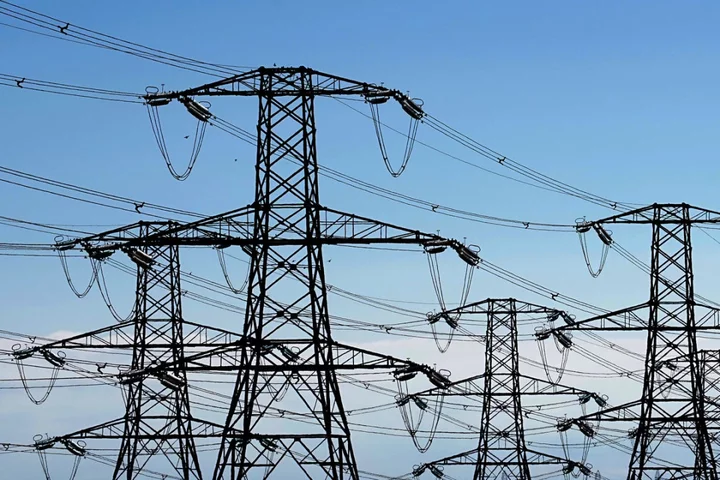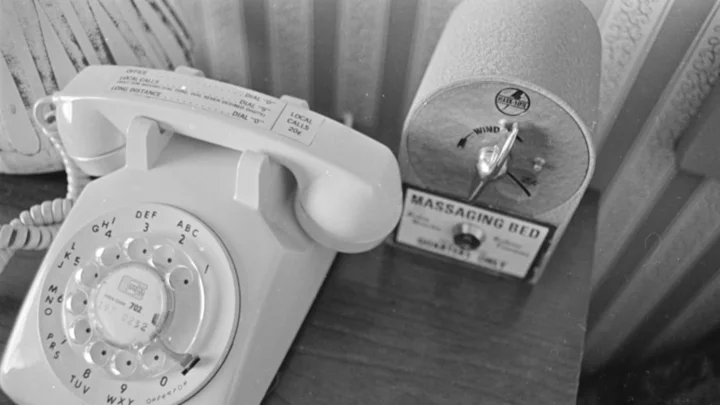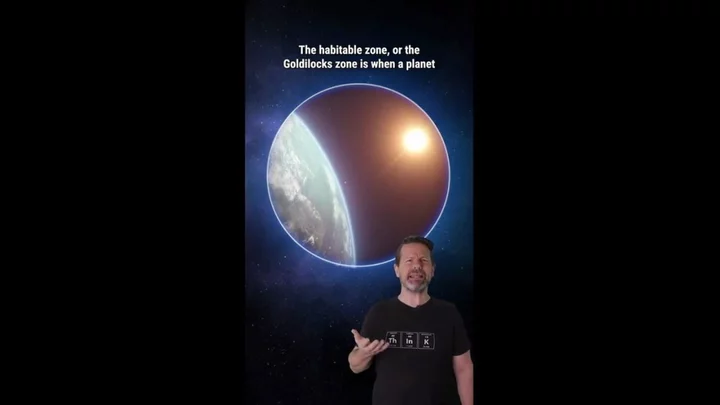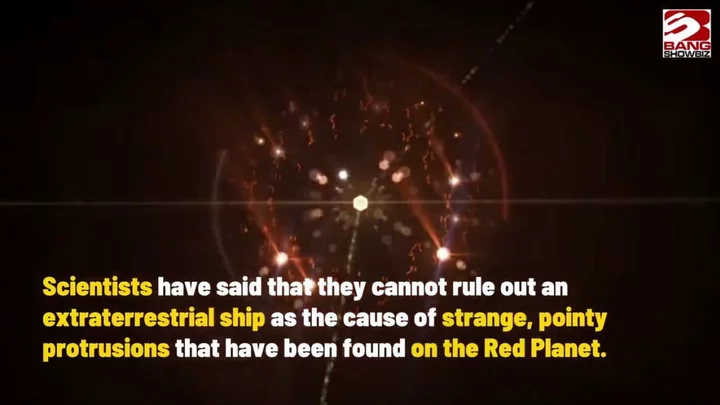
AC is hard on the planet. This building has a sustainable solution
In mid-July at the construction site at 1 Java Street in Brooklyn, New York, the outside temperatures can reach sweltering highs in the 90s. But 500-feet underground, it's 55 degrees all year round.
2023-07-27 19:54

Greece’s Wildfires Burn Through the Country’s Natural CO2 Stores
Greece’s wildfires are burning through the country’s natural carbon sinks in the latest sign of how heat waves
2023-07-27 17:16

Superconductor breakthrough could represent ‘biggest physics discovery of a lifetime’ – but scientists urge caution
Scientists have claimed to make a breakthrough that would be “one of the holy grails of modern physics” – but experts have urged caution about the results. In recent days, many commentators have become excited by two papers that claim to document the production of a new superconductor that works at room temperature and ambient pressure. Scientists in Korea said they had synthesised a new material called LK-99 that would represent one of the biggest physics breakthroughs of recent decades. Superconductors are a special kind of material where electrical resistance vanishes, and which throw out magnetic fields. They are widely useful, including in the production of powerful magnets and in reducing the amount of energy lost as it moves through circuits. They are also often impractical, since they require low temperatures and high pressure. That means that they cannot be used in most traditional circuits, for instance. Since the beginning of the last century, scientists have been working not only to understand superconductivity but also develop new materials that would allow the phenomenon to be harvested at ambient temperatures and pressures. That has not been successful, and the discovery of such a material would mark a major breakthrough in physics. The new papers, published in recent days as a preprint on the website arXiv, claims to have overcome that problem. The researchers said they had not only found a way to synthesise such a superconducting material, but also that it could be done relatively easily – leading to huge excitement on social media. One Twitter thread from Alex Kaplan, a recent Princeton graduate who is now head of coffee product at startup Cometeer, helped propel the news into the mainstream. His thread had been viewed 8.5 million times, Twitter said, and has been retweeted more than 10,000 times. “Today might have seen the biggest physics discovery of my lifetime. I don’t think people fully grasp the implications of an ambient temperature / pressure superconductor,” he wrote in a long thread that went on to explain the possible applications of the material. Mr Kaplan pointed to the fact that vast amounts of energy are lost in the transmission of electricity across the world, that the the authors claimed material could be made in just 34 hours with simple equipment, and that such a superconductor would have revolutionary uses in everything from nuclear fusion reactors to batteries and quantum computers. Scientists away from the work agreed that such a breakthrough would be hugely significant. But they urged caution, pointing to the fact that the paper has not yet gone through the peer review process, the results have not been replicated, and that there could be other explanations for the apparently astonishing behaviour described in the work. “A real, working room-temperature superconductor which works at ambient pressure would be one of the holy grails of modern physics, unlocking major new developments in energy, transportation, healthcare, and communications,” said Mohammad Yazdani-Asrami of the University of Glasgow’s James Watt School of Engineering. “As it stands, however, the paper is not yet peer-reviewed and has not yet been tested in other labs to see if other researchers can reproduce its results. These are both key to determining for sure whether the world should be getting excited about the authors’ claims, which need much more scrutiny at this early stage. If the claims of findings are approved, perhaps, this is one of the most significant achievements of last few decades in physics and material engineering.” Others voiced specific concerns about the paper. Some of the results meant that other researchers working on superconductors were not convinced by the claims made in the paper. “The recent preprint by Lee, Kim and Kwon suggesting that they have observed room temperature superconductivity in the copper doped lead phosphate system, without the need for very high applied pressures, is interesting, but not yet wholly convincing,” said Susannah Speller, Professor of Materials Science at the University of Oxford, and Chris Grovenor, Professor of Materials at the University of Oxford. Professors Speller and Grovenor pointed to the fact that the data did not show the behaviour that would be expected to happen when the material became superconducting. Features that would be expected to be evident in the results were not, they said, and “and so it is too early to say that we have been presented with compelling evidence for superconductivity in these samples”. John Durrell, professor of superconductor engineering at Cambridge University, said that it could take considerable time to see the practical benefits of the breakthrough, even if the team’s results were confirmed. “There will be understandable scepticism about this result in the community as there have been numerous reports of room temperature superconductors over the years which have not held up,” he told The Independent. “I would, therefore, personally withhold judgement on this work until it becomes clear if the result is reproducible in other laboratories. “From my engineering point of view, a practical room temperature superconductor would be potentially transformative – allowing a host of exciting applications such as cheap MRI machines, more compact and efficient motors and low loss power transmission. “However, there can be significant challenges in turning a newly discovered superconducting material into a practical material. In previous cases, this has taken one or two decades and is not always possible.” Read More Europe to cover continent in fast EV chargers under new law Elon Musk takes control of @X account from user who had held it for 16 years iPhone users urged to check their photo library amid fears they could be deleted Europe to cover continent in fast EV chargers under new law Elon Musk takes control of @X account from user who had held it for 16 years iPhone users urged to check their photo library amid fears they could be deleted
2023-07-27 01:25

Whatever Happened to Vibrating Beds?
The buzzing mattresses used to be a staple of seedy motels everywhere. Then they disappeared.
2023-07-27 01:18

Earth-like planet that humans could live on found just 31 lightyears away
A planet with conditions on the surface resembling Earth has been discovered a relatively short distance from us. In fact, it’s just 31 light-years away, which is the space equivalent of 'down the road'. Scientists are always excited when it comes to the discovery of new exoplanets, and this is no different. The planet, named Wolf 1069 b, is the sixth closest exoplanet to Earth has been found and the findings were published in the journal Astronomy & Astrophysics. Sign up to our free Indy100 weekly newsletter It orbits the red dwarf - which is named Wolf 1069. As such, the planet has been given the name Wolf 1069 b. The planet was discovered during a study called CARMENES which is a long-term study based around finding exoplanets. Encouragingly, scientists believe that the planet sits in the habitable zone around its sun where water can exist in liquid form. The study was undertaken by a team led by astronomer Diana Kossakowski of the Max Planck Institute for Astronomy. Kossakowski said: "When we analyzed the data of the star Wolf 1069, we discovered a clear, low-amplitude signal of what appears to be a planet of roughly Earth mass. "It orbits the star within 15.6 days at a distance equivalent to one-fifteenth of the separation between the Earth and the sun." It comes after a new planet was discovered with a surprisingly fluffy composition - like candy floss. The exoplanet, WASP-193b, was discovered 1,232 light-years away and while it's nearly 50 percent bigger than Jupiter, it's light and fluffy making it as dense as the sweet treat. According to a team led by astronomer Khalid Barkaoui of the University of Liège in Belgium, the planet orbits a Sun-like star named WASP-193. This star is around 1.1 times the mass and 1.2 times the radius of the Sun and is very close to the Sun in temperature and age. The planet orbits the star around once every 6.25 days. Have your say in our news democracy. Click the upvote icon at the top of the page to help raise this article through the indy100 rankings.
2023-07-26 23:15

Study reveals the best exercises to lower blood pressure
A study has found the best exercises to lower blood pressure, so get ready to go to the gym. Research published in the British Journal of Sports Medicine and conducted at Canterbury Christ Church and Leicester universities, compared the efficacy of different forms of exercise on reducing blood pressure and found that “isometric exercises” – which involve engaging muscles without moveme are your best bet. That means it is time to hold a wall-sit, or plank for ages. Fun times. The study examined 270 randomised controlled clinical trials, involving 15,827 participants, on the effects of different types of exercise on resting blood pressure. It even found that these isometric techniques were almost twice as effective as government recommended exercises, aerobic activity like cycling and walking, though they found these other forms of exercise were effective too. Reducing blood pressure reduces your chance of stroke, heart failure, and other issues. Sign up to our free Indy100 weekly newsletter Over-40s are advised to have it checked every five years. Treatment often involves medication but patients are also advised to eat healthily, reduce alcohol intake, stop smoking and exercise regularly. Jamie O’Driscoll, a reader in cardiovascular physiology at Canterbury Christ Church university and senior author of the report, said in isometric exercises the muscle remained contracted but did not change in length. This static contraction could squeeze the vessels that supplied blood to the working muscles – which reduced the flow of blood to the muscle during the exercise and therefore oxygen supply to the muscle. When the muscle relaxed afterwards, it caused a large flow of blood through the vessels (this was different to other modes of exercise) and was likely to be the trigger driving these greater improvements in blood flow regulation. “Performing 4 x 2 minutes of wall sits, with 2-minutes’ rest in between, three times per week, is an effective way to reduce your blood pressure,” said O’Driscoll. “They should be done alongside other exercise modes, to provide the maximum range of exercise choices rather than limiting them.” Dr Kush Joshi, a sports and exercise medicine consultant and fellow of the Faculty of Sport and Exercise Medicine, welcomed the study’s findings, but questioned how easy it would be for patients to do. “The reality is a significant proportion of the population will not be able to do a plank or wall sits, and furthermore may not enjoy these types of activities,” he said. “Solutions need to be found to make these exercises accessible to all individuals with elevated blood pressure, and the study should provide impetus to policymakers to make exercise the bedrock of treatment of not only high blood pressure but other medical conditions and so to reduce the burden of medication for the population.” Joanne Whitmore, a senior cardiac nurse at the British Heart Foundation, said it was encouraging to see the benefits of other forms of exercise, as well as aerobic exercise. “We know that those who take on exercise they enjoy tend to carry on for longer, which is key in maintaining lower blood pressure.” But she said it was important to make lifestyle changes too, such as losing weight, eating more healthily and reducing alcohol consumption. Have your say in our news democracy. Click the upvote icon at the top of the page to help raise this article through the indy100 rankings.
2023-07-26 18:53

In Phoenix Heat, Ice-Filled Body Bags Are a Life-Saving Technology
As temperatures hit 119F in Phoenix last Thursday, doctors at Valleywise Health Medical Center saw a patient whose
2023-07-26 18:22

Women Workers to Be Hurt More Than Men by AI Wave, McKinsey Says
Women have more to worry about than men from a coming wave of automation and artificial intelligence that
2023-07-26 12:47

Mysterious 'pyramid' discovered in Antarctica
Conspiracy theorists have been turning their attention to Antarctica more than you’d expect over recent years. First, there was the case of the “bleeding waterfalls”, which remains one of the strangest natural phenomena you're likely to see, and there’s also the mystery of a so-called “pyramid” which has been found on the continent. Only, it’s not a pyramid at all – in fact, it’s a mountain. The Ellsworth Mountains are the highest mountain range in Antarctica and stretch 400km and the mountain in question was discovered by the British Antarctic Expedition of 1910-1913 Sign up to our free Indy100 weekly newsletter It was called “The Pyramid” to keep the true nature of the discovery hidden from others at the time. Over the last hundred years, however, people have been speculating about the true nature of the location (even though it’s very much a mountain, poking up out of the ice) and now a second interesting geographical feature has bee discovered and got them talking all over again. The location in question is found at the coordinates 79°58’39.25?S 81°57’32.21?W, which has been a much-searched spot on Google Earth. Speaking to IFL Science, geologist at the German Research Centre for Geosciences in Potsdam, Dr Mitch Darcy, said: “The pyramid-shaped structures are located in the Ellsworth Mountains, which is a range more than 400 km long, so it’s no surprise there are rocky peaks cropping out above the ice. The peaks are clearly composed of rock, and it’s a coincidence that this particular peak has that shape. “It’s not a complicated shape, so it’s not a special coincidence either. By definition, it is a nunatak, which is simply a peak of rock sticking out above a glacier or an ice sheet. This one has the shape of a pyramid, but that doesn’t make it a human construction.” So, the new location is just that – a mountain poking out the top of the ice in Antarctica, and not a mysterious pyramid at all. Antarctica has been the subject of more than its fair share of speculation recently, after conspiracy theorist Eric Hecker described the Amundsen–Scott South Pole Station by the south pole as an “air traffic control” hub for aliens earlier this year. Hecker claimed that in 2010 Raytheon, the US aerospace and defence conglomerate chose him to be a contractor on the research centre operated by the United States National Science Foundation. There was “much more” to the station that first met the eye, according to Hecker. Have your say in our news democracy. Click the upvote icon at the top of the page to help raise this article through the indy100 rankings.
2023-07-26 00:16

Scientists are claiming an alien spaceship crashed straight into Mars
Is there life on Mars? Well, according to new research, an alien crash landing there could explain puzzling new findings on the surface of the Red Planet. It comes after Nasa’s Curiosity Rover captured images of spiked protrusions on the surface back in April. The strange formations captured in the pictures seem to show a row of spikes and sharp angles emerging from rocks at the base of the Gale Crater, which is 154km long. The odd discovery has put scientists on high alert and it marks one of the most peculiar things ever recorded on the surface of Mars. Sign up to our free Indy100 weekly newsletter Astrobiologist Dr Nathalie Cabrol, who is from the NASA Ames Research Centre and Search for Extraterrestrial Intelligence (SETI) Institute, even said that it’s the “most bizarre” rock she’s seen in 20 years of studying the planet. The findings are so irregular, in fact, that experts cannot rule out the idea that they’re extraterrestrial in origin. “A fragment from an extraterrestrial or terrestrial spacecraft cannot be discounted with absolute certainty” the authors of new research published in the Journal of Astrobiology stated. The odd protrusions could be “sand spikes”, which form in certain sands as a result of strong earthquakes. Another theory posits that the formation could be debris from crashed spacecraft, and authors of the study have not ruled out that it could be the result of crafts launched by humans landing on the surface. "Given that possibly 10 or more craft have crashed upon the surface, coupled with the jettison of equipment associated with landing the rovers, it is possible the spikes and its substrate are human-made and consist of debris that fell onto the surface of Gale Crater," the paper reads. “Nevertheless, no debris field is evident and no evidence of any additional debris that may have originated on Earth. “Given its small size and that there are no known human-made analogs and no logical explanation as to what purpose these spikes may serve, it does not seem likely these specimens are the remnants of craft or equipment that fell into Gale Crater. One can only speculate about extraterrestrial origin." However, speaking to The Telegraph, Prof Richard Armstrong, of Aston University, Birmingham said: “There is no way of proving for certain what the spikes are but the balance of the evidence would suggest ‘sand spikes’ resulting from seismic activity on Mars.” Have your say in our news democracy. Click the upvote icon at the top of the page to help raise this article through the indy100 rankings.
2023-07-25 20:54

Spotify Users Top Expectations Thanks to Gen Z Listeners
Spotify Technology SA, the Swedish audio streaming platform, beat analyst expectations in its second-quarter results with its total
2023-07-25 18:28

The Property Brothers Want to Make Your Home Smarter and Greener
“A smart home is much better than a dumb home,” says Drew Scott. He and his brother, Jonathan
2023-07-25 17:50
